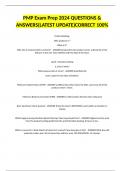PMP Exam Prep 2024 QUESTIONS &
ANSWERS(LATEST UPDATE)CORRECT 100%
Product Backlog:
Who produces it ?
What is it?
Who else is involved with it and how? - ANSWER produced by the product owner, ordered list of the
features in the user story. Refined with the help of the team.
sprint / iteration backlog
Is a list of what?
What purpose does it serve? - ANSWER prioritized list
team's plan for how they will deliver.
Minimum Viable Product (MVP) - ANSWER a NEW product that meets the DoD, some (not all) of the
product owner's vision.
Minimum Business Increment (MBI) - ANSWER an OLD product that has been enhanced
Burn (up/down) charts purpose - ANSWER Tracks the team's REMAINING work within an iteration or
release
What happens during Iteration/Sprint Planning? How long should it be? - ANSWER Highest priority work
from the product backlog pulled into the sprint/iteration backlog. 8 hours or less.
What is covered in a Daily Stand Up?what isn't covered? How long does it last? - ANSWER What they did
yesterday, today, and a list of issues they will face soon. NO DISCUSSION. 15 minutes.
, Product Owner: what are they responsible for (2)? What do they decide? - ANSWER responsible for
product vision, prioritizing the backlog, decides if an increment will be release
PM / Scrum master role does what with what type of leadership? - ANSWER Shields team from
distractions, servant leader
Supportive PMO type does what? - ANSWER Develops best practices, methods, standards, templates.
Coach, mentor, train PMs. (don't have to follow but provides support)
Controlling PMO type does what? - ANSWER Monitors compliance with project procedures via audits.
You HAVE to follow their rules.
Directive PMO type does what? - ANSWER They manage shared resources and coordinates
communication across projects.
ACoE PMO Type does what? - ANSWER Enable projects instead of manage them. They coach teams,
build agile mindset and skills, mentors sponsors and product owners
Portfolio vs Program vs Project - ANSWER see image
4 types of Organizational Structures - ANSWER 1. Functional
2. Matrix
3. Projectized
4. Composite
functional organizational structure
PM power and team attributes - ANSWER PM power: very LITTLE, functional manager has the power
because the team reports to the functional manager. Team members work part-time on the project
matrix organizational structure
,PM power and team attributes - ANSWER PM power: can be weak, balanced, or strong (but not total)
control. Team members have conflicted loyalty, they report to both the PM and their FM. Team works
part-time on the project
projectized organizational structure
PM power and team attributes - ANSWER PM power: high control. Team members report to the PM,
work full time on projects, and are loyal to the project
composite organizational structure - ANSWER Does not fit into the other org structures
Agile Principle: Satisfy __________ through early and continuous delivery - ANSWER customers
Agile Principle: Welcome __________ even late in development - ANSWER change
Agile Principle: Deliver working software __________ - ANSWER quickly!
Agile principle: People should be self-__________. Give them the __________ they need to get the job
done but trust them to do it. - ANSWER motivated, support
Agile principle: The most efficient way of conveying information within a team is __________
conversation - ANSWER face-to-face
Agile principle: __________ __________ is the primary measure of success - ANSWER WORKING
software(products)
Agile principle: Sponsors, the team, and users should be able to maintain a __________ __________
indefinitely. - ANSWER constant pace
Agile principle: Continuous attention to technical excellence and __________ __________ enhances
agility. - ANSWER good design
, Agile principle: __________ - the art of maximizing the amount of work not done, is essential - ANSWER
simplicity
Agile principle: teams should be __________ organized - ANSWER self
Agile principle: The team regularly reflects on how to become more __________, and then adjusts
accordingly - ANSWER effective
Selecting a hybrid approach means that - ANSWER We are tailoring the approach to what is best for the
project needs
Strategic Management Elements and Framework triangle chart - ANSWER
Enterprise Environmental Factors (EEFs) definition plus examples - ANSWER External GIVENS not in the
control of the project team.
Internal or external to the company.
Internal examples: Company culture, geographic distribution of employees, IT software
External examples: social, political, cultural influences, legal restrictions, government standards, working
conditions, weather, academic research
Organizational Process Assets (OPAs) - ANSWER Internal ASSETS in the control of the project team
Examples: org charts, templates, processes, procedures, guidelines, databases, historical information,
procurement rules, hiring/on boarding procedures.
PESTLE, TECOP, and VUCA are ... - ANSWER ways of understanding external risk, uncertainty, and
opportunities that can affect the value and desired outcome of a project
What's two main things happen during the Sprint Demo? How long does it usually last? - ANSWER
Inspects the outcome of the iteration with stakeholders, collects feedback. 4 hours or less.




